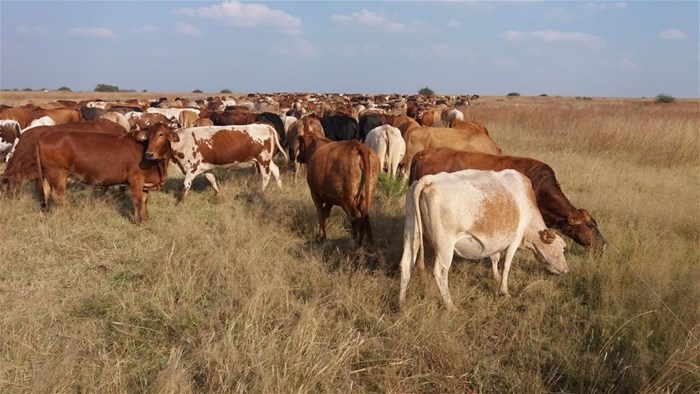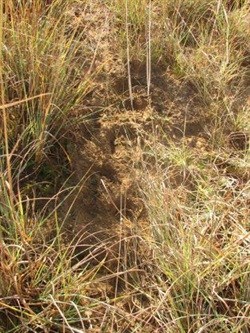






The saying may go that a livestock farmer is, in fact, a grass farmer, but this concept is refined even more by the system as it improves the soil structure, increases water retention capacity, creates a more favourable environment for microbes, and eventually improves the grazing quality of the grasses.
• Know your resource base.
• Manage to ensure sufficient plant rest.
• Manage for optimal plant utilisation.
• Improve the soil condition.
• Control bush encroachment.
• Plan for droughts.
• Monitor the resource base.
• Plan infrastructure to complement resource utilisation.
• Effective rangeland management
Bertus Kruger, a grassland scientist at the African Game Ranchers’ Association (AGRA), says these principles were developed over a four-year period. "The main challenge is how these principles should be applied to the soil under different situations. In Namibia, any grazing system that applies the above-mentioned principles is encouraged. The goal is to improve and sustainably maintain natural grazing, the cheapest resource for the country’s cattle farmers.
"The system of high density and ultra-high density grazing was developed by scientists and grassland scientists in different parts of the world. It is based on the way nature protects grazing and improves the structure of the soil where plants grow.
"Over time, they have observed that game utilise grazing in a specific manner and that the soil where grass grows on the plains is extremely fertile. The animals graze in large herds, do not linger in the same spot and do not necessarily feed selectively. High-density grazing enforces the same pattern, as a large herd of livestock utilise all plant species in a relatively small camp for a day or three before they are moved to the next camp."
Scientists agree that this type of grazing system can improve the rangeland, soil structure and meat production per hectare, but it certainly also requires good management skills.
Hennie du Toit, an animal scientist at Obaro’s Animal Production department, says in view of the rising demand for food due to a growing global population, it is necessary for farmers to change their grazing strategies for better utilisation of grazing crops, as well as for conservation and improvement of resources.

New technology is available to increase a farm’s carrying capacity up to 600% while simultaneously improving the soil structure and quality of the grazing.
High-density grazing (small camps) and ultra-high density grazing (strips in camps) are some of the grazing systems that can allow farmers to reach this goal. To understand how it works, you need to know the physiology of plant roots.
Hennie says roots are where the plant’s food reserves are stored – these reserves are used by the plant for regrowth after it has been grazed down. "If a plant has been grazed extremely short, it extracts more reserves to produce leaves and regrowth is slower. As more leaves form, food reserves are restored in the roots.
"If the regrowth is utilised before reserves are re-channelled to the roots, even more, reserves are extracted. If this happens continuously, the root mass and plant become smaller and grass production declines. Palatable and preferred species will become extinct due to overgrazing, the carrying capacity will decline and livestock production will become unsustainable. Plant cover will dwindle, water run-off will increase, water infiltration will decrease, and the soil structure will weaken."
High density and ultra-high density grazing counter these adverse processes. The short grazing periods and long resting periods provide grass with an opportunity for enough regrowth, so root reserves can be built up again.
High-density grazing entails that large herds of animals being herded into one camp to eat all the grazing within twelve to 14 days before being moved to the next camp. It is generally accepted that the camp size should be a maximum of 20% of the herd size. If there are 100 animals in the herd, the camp should be no bigger than 20ha.
If more animals are available or the camps smaller, the farmer switches to ultra-high density grazing, where the animals are kept in a camp for a maximum of one day, or where strips of grazing are made available using electrified wires – the grass will be grazed down within an hour or two.
Since the animals in these systems also utilise the unpalatable species, it will take much longer to use the same camp again. Hennie says the goal should be to prevent the weakest veld from being grazed for a whole growth season, but it must be grazed properly in winter.
"The roots will soon recover and as food reserves increase, the root systems will become bigger and stronger, enabling it to store more reserves. Grass production and species composition will also improve, which will increase the carrying capacity.
"A large number of animals, as many as 5,000 animals per hectare, tend to loosen the top layer of the soil and trample old grass tufts. As a result of the hard crust that promotes water run-off and complicates water infiltration, is broken. The loose topsoil allows for better water infiltration and aerated soil, which is extremely beneficial. Unused grass is also trampled in the process.
"The concentration of manure and urine along with the finely trampled grass, will put organic matter back into the soil. This creates an ideal environment for microbes in the top layer of ‘healthy’ soil, which are necessary for good plant growth. An outstanding seedbed is formed, and where there are many grass seeds, the conditions for germination in the new season will be exceptional and new plants will be able to grow on bare patches."
During high density grazing, the animals disturb the soil crust and trample organic matter into the soil. A favourable seedbed is created for new plants to germinate and grow.

The thicker the fertile topsoil layer, the higher the veld’s grass production will be and the higher the carrying capacity will become. The effect of below average rainfall will also be smaller on such fertile soil.
As the grazing improves, the carrying capacity will also improve and allow for more animals to be kept on the same farm. In certain areas, it is possible to eventually achieve a carrying capacity of one large stock unit per hectare.
Implementation of such a grazing system will differ from one farm to another, though, and is influenced by the layout of the farm, available money, how many breeding cows are kept, as well as other varying factors.
Photographs supplied by Hennie du Toit

AgriOrbit is a product of Centurion-based agricultural magazine publisher Plaas Media. Plaas Media is an independent agricultural media house. It is the only South African agricultural media house to offer a true 360-degree media offering to role-players in agriculture. Its entire portfolio is based on sound content of a scientific and semi-scientific nature.
Go to: http://agriorbit.com/